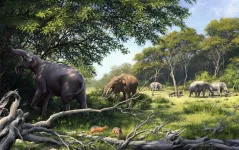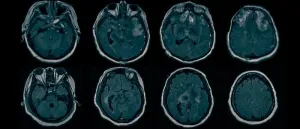(Press-News.org) The latest study about of proboscideans (elephants and their ancient relatives) from the University of Helsinki provides proof that some proboscideans started to adapt to locally grass-rich environments in East Africa first by changing their behavior and starting to feed more on grasses. This happened in some lineages of proboscideans, such as choerolophodonts, much earlier than has been thought until now, about 23 to 11 million years ago in parts of East Africa
Also, around 7 million years ago in the lake Turkana region, increasingly grass-rich diets of the earliest true elephants were associated with dryer and more grass-rich savanna environments than elsewhere in East Africa.
“This supports the hypothesis of such regions as “species-factories” where evolutionary adaptation to changing environmental conditions first centered around”, says Juha Saarinen from the University of Helsinki, who led the research.
Feeding on grasses is more demanding on teeth than feeding on most other kinds of plants due to a high content of mineral grains called phytoliths in their leaves, causing heavy abrasion on teeth.
Nonetheless, during the Early and Middle Miocene the choerolophodont lineage of proboscideans were able to shift to more grass-rich diets with relatively modest changes in the morphology of their teeth.
Since about 10 million years ago, major changes in climate had a more profound effect on the evolution of proboscidean teeth in East Africa, especially the evolution of true elephants (Elephantidae) with highly specialized high-crowned, multi-ridged molar teeth.
“We were able to show that the strongest peaks of drying of the East African climate during the last 7 million years (for example about 4 and 2 million years ago) correspond with evolutionary bursts in the increase of tooth crown height and the number of ridges on the molar teeth, while these evolutionary changes did not reverse during periods of less harsh climatic conditions” says Saarinen.
“This supports earlier suggestions that adaptive traits in organisms are adaptations to extreme rather than average environmental conditions.”
Comparing evidence of past vegetation and the diet of elephants during the last 7 million years also showed an increase of grasslands and increasing dominance of grass-feeding elephants with highly specialized teeth throughout that period in most parts of East Africa. However, during the last 100 000 years this situation changed probably because of drastic fluctuations in global climate and eventually only the dietarily more generalist modern African savanna elephant (Loxodonta africana) with less specialized teeth survived in East Africa. Ecological generalism might similarly explain the survival of Asian elephant (Elephas maximus) in Asia, while the African forest elephant (L. cyclotis) was able to find refuge in more forested parts of Central and Western Africa.
“The ecologically quite versatile modern elephants were the sole survivors of the tumultuous climate changes of the late Pleistocene. Now it’s us humans that threaten the last surviving species of this ecologically important group of animals, and we should work hard to keep them from being lost forever.”
END
Elephant ancestors´ teeth evolved in response to long term changes in diet and climate in Africa
A new study shows that the cheek teeth of proboscideans (elephants and their ancient relatives) evolved in response to dietary changes due to vegetation changes and climate change in East Africa during the last 26 million years.
2023-08-14
ELSE PRESS RELEASES FROM THIS DATE:
Cleveland Clinic study shows deep brain stimulation encouraging for stroke patients
2023-08-14
CLEVELAND: A first-in-human trial of deep brain stimulation (DBS) for post-stroke rehabilitation patients by Cleveland Clinic researchers has shown that using DBS to target the dentate nucleus – which regulates fine-control of voluntary movements, cognition, language, and sensory functions in the brain – is safe and feasible.
The EDEN trial (Electrical Stimulation of the Dentate Nucleus for Upper Extremity Hemiparesis Due to Ischemic Stroke) also shows that the majority of participants (nine out of 12) demonstrated ...
How our tastes influence our creativity
2023-08-14
What drives us to develop new ideas rather than settling for standard methods and processes? What triggers the desire to innovate at the risk of sacrificing time, energy, and reputation for a resounding failure? Creativity is based on complex mechanisms that we are only beginning to understand and in which motivation plays a central role. But pursuing a goal is not enough to explain why we favor some ideas over others and whether that choice benefits the success of our actions.
"Creativity can be defined as the ability to produce original ...
Inoue receives funding for group digital gaming: Experiences of older adults living with dementia in an activity for cognitive impairment
2023-08-14
Megumi Inoue, Associate Professor, Social Work, received funding for: "Group Digital Gaming: Experiences of Older Adults Living with Dementia in an Activity for Cognitive Impairment."
The purpose of this study is to examine the effects of a group digital gaming intervention on cognitive function, mood, and behaviors in people with early to moderate levels of dementia. A group digital gaming company, called Obie Technology, was developed to facilitate cognitive stimulation, physical exercise, and group interactions simultaneously. ...
IIR researchers receive funding for conference focused on refugee resettlement and STEM education
2023-08-14
James C. Witte, Professor, Sociology, Director, Institute for Immigration Research (IIR), and Michelle S. Dromgold-Sermen, Assistant Director, IIR, received funding for: "Refugee Resettlement and STEM Education."
This conference will focus on how STEM-oriented educational opportunities through high schools, registered apprenticeships, community college, and four-year institutions can all play a significant role in addressing urgent humanitarian needs, while also expanding the nation’s STEM workforce.
Participants will learn about the current refugee situation, how the Welcome Corps is a valuable addition to U.S. refugee ...
New study charts exposure to SARS-CoV-2 infection in Canada throughout the pandemic
2023-08-14
Most people in Canada now have hybrid immunity against SARS-CoV-2 through a mix of infection and vaccination, new research in CMAJ (Canadian Medical Association Journal) shows.
VIEW EMBARGOED ARTICLE
Using pan-Canadian blood sample data from a subset of studies backed by the COVID-19 Immunity Task Force (CITF), researchers from the CITF, in collaboration with those from supported studies, estimated changing levels of seroprevalence — from infection or vaccination, or both — over 3 time periods: prevaccination (March to November 2020), vaccine roll-out (December 2020 to November 2021) and the Omicron waves (December 2021 to March 2023). In the first 2 phases, seroprevalence from ...
Source of hidden consciousness in ‘comatose’ brain injury patients found
2023-08-14
NEW YORK, NY (Aug. 14, 2023)--Columbia researchers have identified brain injuries that may underlie hidden consciousness, a puzzling phenomenon in which brain-injured patients are unable to respond to simple commands, making them appear unconscious despite having some level of awareness.
“Our study suggests that patients with hidden consciousness can hear and comprehend verbal commands, but they cannot carry out those commands because of injuries in brain circuits that relay instructions from the brain to the muscles,” says study leader Jan Claassen, MD, associate professor of neurology at Columbia University Vagelos College of Physicians ...
Publicly fund nonsurgical procedures for transgender, gender diverse people
2023-08-14
Publicly fund nonsurgical procedures for transgender, gender diverse people
To support transgender and gender-diverse people, governments should consider publicly funding hair removal and other minimally invasive procedures, authors argue in a commentary in CMAJ (Canadian Medical Association Journal).
VIEW EMBARGOED ARTICLE
“Minimally invasive procedures such as hair removal and facial injectables may support the process of transition in a timely fashion; evidence supports their therapeutic benefits in the field of gender-affirming care,” write Drs. Katie Ross and Sarah Fraser, Faculty of Medicine, Dalhousie University, Halifax, Nova Scotia.
The ...
Chromium replaces rare and expensive noble metals
2023-08-14
Expensive noble metals often play a vital role in illuminating screens or converting solar energy into fuels. Now, chemists at the University of Basel have succeeded in replacing these rare elements with a significantly cheaper metal. In terms of their properties, the new materials are very similar to those used in the past.
We’re familiar with chromium from everyday applications such as chromium steel in the kitchen or chrome-plated motorcycles. Soon, however, the element may also be found in the screens of ubiquitous mobile phones or used to convert solar energy. Researchers led ...
No longer ships passing in the night: these electromagnetic waves had head-on collisions
2023-08-14
NEW YORK, August 14, 2023 — A research team at the Advanced Science Research Center at the CUNY Graduate Center (CUNY ASRC) has shown that it is possible to manipulate photons so that they can collide, interacting in new ways as they cross paths. The discovery, detailed in Nature Physics, will allow scientists who develop technologies rooted in electromagnetic wave propagation to make significant advances in telecommunications, optical computing and energy applications.
The breakthrough took place in the lab of Andrea Alù, Distinguished ...
Comparison of particulate air pollution from different emission sources and incident dementia
2023-08-14
About The Study: In this nationally representative study, higher residential levels of fine particulate matter were associated with greater rates of incident dementia, especially for fine particulate matter generated by agriculture and wildfires. These findings also indicate that intervening on key emission sources might have value, although more research is needed to confirm these findings.
Authors: Boya Zhang, Ph.D., of the University of Michigan School of Public Health in Ann Arbor, is the corresponding ...
LAST 30 PRESS RELEASES:
Post-stroke injection protects the brain in preclinical study
Cardiovascular risk score predicts multiple eye diseases
Health: estimated one in ten British adults used or interested in GLP-1 medications for weight loss
Exercise to treat depression yields similar results to therapy
Whooping cough vaccination for pregnant women strengthens babies’ immune system
Dramatic decline in new cases of orphanhood in Uganda driven by HIV treatment and prevention programs
Stopping weight loss drugs linked to weight regain and reversal of heart health markers
Higher intake of food preservatives linked to increased cancer risk
Mass General Brigham–developed cholera vaccine completes phase 1 trial
First experimental validation of a “150-year-old chemical common sense” direct visualization of the molecular structural changes in the ultrafast anthracene [4+4] photocycloaddition reaction
Lack of support for people on weight loss drugs leaves them vulnerable to nutritional deficiencies, say experts
Dogs’ dinners can have greater climate impact than owners’
Are you ready to swap salmon for sprats and sardines?
1.6 million UK adults used weight loss drugs in past year
American College of Cardiology comments on new dietary guidelines for Americans
American Society of Gene & Cell Therapy and Orphan Therapeutics Accelerator partner to advance and commercialize promising rare disease treatments
One in 14 patients having day case surgery have new or worse chronic pain 3 months after their operation
New study highlights link between eviction rates and gun violence
Heatwaves heat up soil but not toxin levels in rice, study finds
Digital modeling reveals where construction carbon emissions really come from
Turning farm waste into water filters
New study shows how the spleen helps the immune system accept a transplant
New Mayo Clinic study advances personalized prostate cancer education with an EHR-integrated AI agent
Researchers identify novel therapeutic target to improve recovery after nerve injury
Microbes in breast milk help populate infant gut microbiomes
Reprogramming immunity to rewrite the story of Type 1 diabetes
New tool narrows the search for ideal material structures
Artificial saliva containing sugarcane protein helps protect the teeth of patients with head and neck cancer
Understanding the role of linear ubiquitination in T-tubule biogenesis
Researchers identify urban atmosphere as primary reservoir of microplastics
[Press-News.org] Elephant ancestors´ teeth evolved in response to long term changes in diet and climate in AfricaA new study shows that the cheek teeth of proboscideans (elephants and their ancient relatives) evolved in response to dietary changes due to vegetation changes and climate change in East Africa during the last 26 million years.






